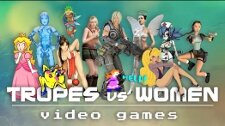At this point, a lot of indie game developers try to make mind-bending puzzle games. Portal helped bring back the genre in a huge way with the taunting narrator and level manipulating mechanic. A lot of games fail to even offer a fair challenge, mistaking difficulty or narrow unmarked accuracy fields as compelling game design.
 Not Thomas Was Alone. Mike Bithell didn’t fall into the “harder is better” trap with his rectangular puzzle/platformer game. He creates a captivating environment with very minimalistic graphics that will draw you in with charm and humor.
Not Thomas Was Alone. Mike Bithell didn’t fall into the “harder is better” trap with his rectangular puzzle/platformer game. He creates a captivating environment with very minimalistic graphics that will draw you in with charm and humor.
Thomas is an anomaly in a computer system. He’s a randomly generated error shaped like red rectangle. He begins to explore the world that created him, reaching for teleportation outlines that bring him to the next area.
The computer system begins creating other errors with other abilities. John is a tall skinny rectangle that jumps exceptionally high. Claire is a large blue square that can float on the water–a deadly element to the other glitches. Together, the team of seven shapes begin to go further and further in the computer world that made them and wishes to destroy them.
For a game with rainbow-hued rectangles on muted backgrounds, Thomas Was Alone sure has an engaging story and great character development. The seven glitches fall in love, like each other, hate each other, and distrust each other in equal measure.

Charm and character development are not a substitute for good gameplay and responsive controls in a puzzle/platformer. Thomas Was Alone proudly stands as a well-executed game. The controls are simple. You use up, left, and right (or WAD if you prefer) to move the characters and Q/E (PC/Mac) or shoulder buttons (PS3/Vita) to toggle between characters. A row of colored squares appear on the corner of the screen to let you see the order of the toggle. The game automatically centers on the active character, as well.
The level design is challenging but not so exacting that only one out of hundreds of possibilities of landing a jump is correct. Some levels are just simple platforming, moving the characters from the beginning to the end in a clear path. Others require cooperation between the characters–building staircases for smaller players to climb, floating on Claire’s back to pass through water unscathed.

While the opening text of each level derides the characters, the cast of Thomas Was Alone is best represented by Claire’s introduction to the game. Claire believes her ability to float makes her a superhero. She is proud of the fact that she can do a job no one else in the computer world can. The more she helps characters, the more satisfied she feels with the hand she was dealt.
Each of the seven characters in Thomas Was Alone is a superhero to the other characters. They just don’t all realize it. They have phenomenal abilities that allow the entire crew to pass through without detection by the menacing pixel cloud in the sky. The game is a crash course in teamwork and a very smart commentary on learning to believe in yourself. It has the biting wit of Portal which a much more life-affirming message.
Thomas Was Alone is available to download on PC, Mac, PS3, and PS Vita. You can score the PC version through next Sunday (9 June) as part of Humble Indie Bundle 8 with Little Inferno, Awesomenauts, Capsized, and Dear Esther (!!!) for as little as $1. Beat the average price and you also get Hotline Miami and Proteus.
Thoughts on Thomas Was Alone? Share them below.



 Unsurprisingly, before I even got a chance to watch Tropes vs. Women in Video Games: Damsel in Distress (Part 2),
Unsurprisingly, before I even got a chance to watch Tropes vs. Women in Video Games: Damsel in Distress (Part 2), 



 Cold Mountain, a forgotten survival horror gem for the Nintendo Wii, gets controls as a storytelling device just right. Eric Simmons travels to the Himalayas to try to find his younger brother Frank. Frank was hired to hunt for artifacts in the mountain range and never returned. Eric arrives at the small mountain town to find it totally abandoned. It’s like the locals had no choice but to leave immediately.
Cold Mountain, a forgotten survival horror gem for the Nintendo Wii, gets controls as a storytelling device just right. Eric Simmons travels to the Himalayas to try to find his younger brother Frank. Frank was hired to hunt for artifacts in the mountain range and never returned. Eric arrives at the small mountain town to find it totally abandoned. It’s like the locals had no choice but to leave immediately.
